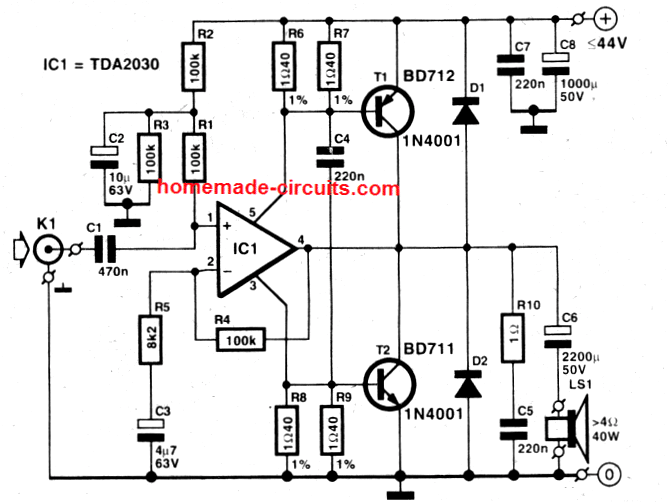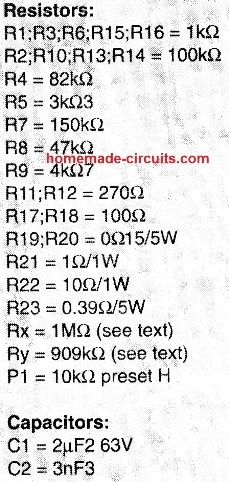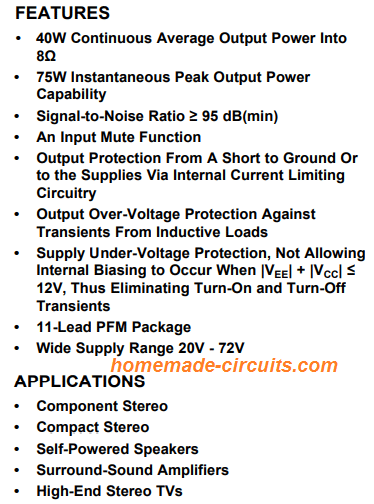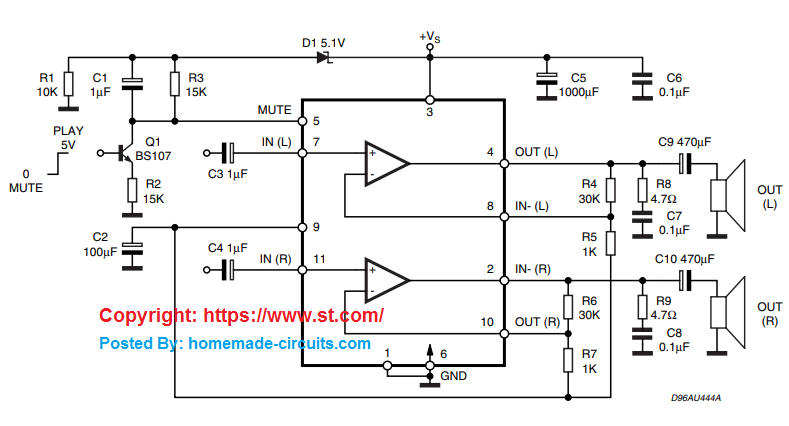In this post I will talk about 5 outstanding, easy to build, low distortion Hi-Fi 40 watt amplifier circuits that can be further upgraded to higher wattage through some minor tweaks.

This article was contributed to me through email by a dedicated follower
Although you may find several hybrid output modules available, hardly any of these are able to blend simplicity with affordability along with great overall performance.
One of them is SGS's chip TDA2030 employed in the present amplifier. The layout of the amplifier is uncomplicated: a power opamp accompanied by two bridge tied output transistors. The audio signal is given to the non-inverting input of power opamp lC1 through socket K1 and capacitor C1.
The supply current to the IC oscillates according to the input signal.
Due to this, it exhibits equally changing voltage drop around resistors R6, R7. R8, and R9 given that these are in the source lines to the opamp. So long as the current is below 1 A, the voltage drop over the resistors is going to be inadequate to turn on transistors T1 and T2. Which means outputs up to 2 W into 4 Ohm speakers are supplied totally by the opamp.
As soon as the output current gets higher than a level of 1 A, the transistors are switched on and reinforce the power output of the amplifier.
If the input signal is low results in insufficient quiescent current through the transistor, however since this happens through the opamp crossover network, issues are eventually evaded.
The IC additionally delivers thermal compensation, and therefore ensures guaranteed stability of the operating point.
The supply voltage might range between 12 V and an absolute maximum of 44 V. Building of the amplifier on the PCB must be easy.
The transistors along with the IC should be installed and insulated on to a heat sink of approximately 2 k W-1. Apply lots of heat conducting composite. The supply line needs to be guarded by a 3.15 A fuse. line should be protected by a 3.15 A fuse.
Circuit Diagram

PCB Design

Parts List
Resistors, all 1/4 watt 5% unless specified
- R1 to R4 = 100K
- R5 = 8k2
- R6 to R9 = 1. 4 ohm 1%
- R10 = 1 ohm
Capacitors
- C1 = 470 nF
- C2 = 10uF, 63V radial
- C3 = 4.7uF, 63V radial
- C4, C5, C7 = 220 nF MKT or Ceramic
- C6 = 2200uF, 50V radial
Semiconductors
- D1, D2 = 1N4007
- T1 = BD712
- T2 = BD711
- IC1 = TDA2030
Miscellaneous
- K1 = Audio socket, or jack
- Heatsink = 2K W^-1
- Insulating washers etc for IC1, T1, T2
Technical Specifications
Operating Voltage: 44V Maximum
Output Power = 22 watt in 8 Ohm Speaker and 40 watts in 4 Ohm speaker with THD = 0.1%
Harmonic Distortion Chart
- 1 kHz in 8 ohm at 11 watt = 0.012%
- 1 kHz in 4 ohm at 20 watt = 0.032%
- 20 kHz in 8 ohm at 11 watt = 0.074%
- 1 kHz in 8 ohm at 1 watt = 0.038%
- 1 kHz in 4 ohm at 1 watt = 0.044%
- Quiscent Current = 38mA approximately
- Efficiency = 8 Ohm 62.5%
- Maximum Load = 4 Ohm 64%
2) 40 Watt Amplifier using IC LM391
This second design is a powerful, no-frills medium power amplifier that may be specifically matched to use in ‘combo‘ type of portable amplifiers which are popular with guitarists and jazz music artists.
The amplifier is an efficient blend of a built-in audio driver IC the LM391-80, and a push-pull power output stage built with bipolar transistors.
A few unique aspects of the design are reviewed below.
The NTC, which is in physical contact with the power output transistors, allows the LM391 to shut off the power stage when this overheats. The starting point of this heat safety is situated at an NTC current of about 200 pA.
The electrolytic capacitor grounding the NTC acts to present a ‘soft start',which is, to avoid a noisy click on or other befuddling noise from the loudspeaker when the amplifier is toggled on.
It might seem that the protection is way too sensitive, and therefore some trial and error for the value of R4 or that of the NTC, might be required. It is easy to apply feedback in the amplifier by connecting R23 to line network C5-R7.
The other components, along with R10 decide the frequency response of the amplifier which might require fine-tuning to fulfill specific demands. The component numbers I have I have explained in this article may, nonetheless be okay for the majority of applications.
The result of experimenting with different values of C5 and R7 is easy to determine (or hear) by shorting out R23 briefly. For 4 Ohm loudspeakers, R23 needs to be reduced to 0.18 Ohm. Sadly, the LM391-80 is vulnerable to oscillation, which must be kept under control through components RX, C6, C8 and C9 (in many instances, C6 could be removed).
Resistor RX specifically minimizes the open-loop gain. If RX is employed, Ry has to be attached to compensate the resulting off-set voltage. Components R22 and C12 constitute a Boucherot network which functions to stabilize the amplifier at high frequencies. The input of the amplifier must be operated by a low-impedance source which is able to deliver ‘line’ level audio signals (0 dB].
Network R1-C1 attenuates amplitudes above 50 kHz or so. The quiescent current of the amplifier is defined by preset P1. Adjust this control to 0 Ohm in the beginning, and fine tune it right up until a quiescent current of 50 mA is established.
You can increase this to 400 mA should you be looking for low distortion. The power transistors are all positioned at the same section of the PCB in order that they could be clamped onto a common heatsink, along with the NTC.
The heat sink needs to be pretty large with a thermal resistance of 1 K Wsl or lesser. Observe that L1 is made of 20 turns of 0.8 mm dia. enameled copper wire wound around R21. C9 is a ceramic capacitor.
Circuit Diagram

Technical Data
Now let's check out, a few tested data:
With supply voltage: 35 V; R23 short-circuited:
3-dB bandwidth (8 Q]: approx. 11 Hz to 20 kHz
THD (transient harmonic-distortion) at 1 kHz: . 1 W into 8 Ohm: 0.006% (Iq = 400mA) 1 W into 8 Ohm: 0.02% (Iq = 50 mA) 65 W into 8 Ohm: 0.02% (Um = 873 mV) 80 W into 4 Ohm: 0.2% (Um = 700 mV; onset level of current limit).
PCB and Component Layout

Parts List


3) 40 watt Power Amplifier using IC LM2876 from Texas Instruments
The third design is yet another cool Hi-Fi 40 watt power amplifier circuit which utilizes a single chip LM2876 for delivering the specified amount of music power over a 8 ohm speaker.
The IC LM2876 is a high-grade audio amplifier chip which is designed to continuously handle 40 watts of average power over an 8 Ohm loudspeaker with a THD of 0.1%, and a frequency range of 20 Hz to 20 kHz.
The performance of this IC is far better than other hybrid ICs due to its built in feature called Self Peak Instantaneous Temperature control circuitry, or the SPiKe.
The "SPiKe" includes a complete protection of the chip against output over-voltage, under-voltage, overload and accidental short circuits.
The IC LM2876 exhibits excellent signal-to-noise ratio above 95 dB, guaranteeing excellent Hi-Fi level sound clarity and reproduction.
Pinout Diagram of LM2876

Circuit Diagram
The complete circuit diagram of this LM2876 based 40 watt amplifier is presented below:


For more info on this please visit the datasheet of the IC
4) 40 watt Stereo Amplifier Circuit using IC TDA7292
So far we have discussed amplifiers with mono 40 watt output, however this fourth circuit in the list is designed to offer a stereo 40 + 40 watt output through a single chip IC TDA7292. So if you are looking for a stereo version of 40 watt amplifier then this design will fulfill your requirement very easily.
This outstanding single chip stereo amplifier is manufactured by ST microelectronics.
The circuit requires hardly any components and could quickly configured using a well deigned PCB which is furnished in the datasheet irself.
Main Features
- Wide supply voltage range (from +/-12 V ± 33 V)
- Works with dual supply for optimal output power
- Designed to deliver full output power 40 W + 40 W into 8 Ω with supply voltage = ±26 V and Total Harmonic Distortion not more than = 10%
- Internally eliminated “pop” sound when power is turned on/off
- Feature a Mute option which is also (“pop”-free)
- When the Mute pin is grounded, the IC goes into a low consumption Standby more.
- Internally the IC is Short-circuit protected, meaning th IC will not burn or get damaged when output is accidentally short circuited or over loaded.
- Also, the IC features an in-built Thermal overload protection, so overheating will also not damage the IC.
Complete Circuit Diagram

Absolute Maximum Rating
The following are the maximum absolute rating of the IC TDA7292, that should not be exceeded to safeguard the IC from getting permanently damaged:
- DC supply voltage ±35 V
- (IO) Output peak current (internally limited) 5 A
- (Ptot) Power dissipation Tcase = 70°C 40 W
- (Top) Operating temperature -20 to 85 °C
- (Tj) Junction temperature -40 to 150 °C
- (Tstg) Storage temperature -40 to 150 °C
Reference: For more details and the complete PCB design, you can refer to the original datasheet of the IC.
5) 40 Watt Amplifier with only Transistors
All the designs explained above are dependent of integrated circuits, and we all know how easily these ICs can get obsolete at any point of time. Perhaps the best way to have a universal evergreen amplifier design is to have it in the form of discrete transistorized version, as shown in this fifth final design:

This is actually the shortened version of the popular 100 watt amplifier from this website. It has been simplified by removing a couple of mosfets and reducing the supply input to 24V.
The parts indicated in the above transistorized 40 watt amplifier circuit looks a little unconventional and might not be readily available in the market. However, the beauty of such transistorized versions is that the active components can be easily substituted with equivalent values. For this design also we can find the appropriate equivalents and replace them here for getting the same flawless results.
The amplifier is superbly designed by the Hitachi engineers for delivering outstanding clarity with minimum distortions. I have tested it and was quite thrilled with its huge adjustable power range and exceptional output quality.
For the entire parts list please visit this article.

Have Questions? Please Comment below to Solve your Queries! Comments must be Related to the above Topic!!